16 Pretty Pink Flowers For Your Garden
Put the versatility of pink blooms to work in your garden with these charming selections.
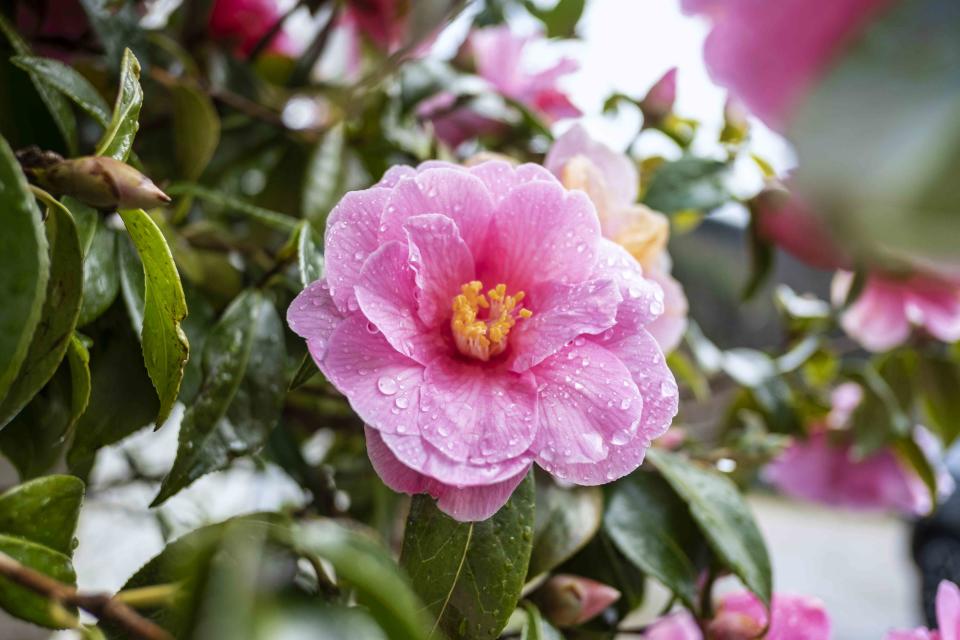
Getty Images/Ana Iacob
Pink is a versatile color in the garden. Depending on their tone, pink flowers can evoke a range of moods, from warmth and comfort to energy and excitement. We’ve gathered a collection of the prettiest pink flowers to elevate your garden, from soothing blush pink roses to vibrant magenta coneflowers. Make the most of these blooms by learning how to combine this diverse color palette with other landscape hues.
Pink flowers come in both warm and cool color tones and can be paired with every color on the spectrum. Warm pinks such as coral, rose, salmon, and blush are calming and convey feelings of peace, compassion, softness, and nurturing. They combine well with other warm colors like yellow, red, and orange.
Cool pinks have names like fuchsia, raspberry, bubblegum, and magenta. They are more vibrant and livelier, evoking energy and joy. Cool pink flowers complement blues and purples. Before selecting pink blooms for your garden, consider the general color scheme you wish to build or accentuate. Your gardens will look their best when you group flowers from the same color temperature together. Many of the flowers on this list are available in a variety of hues to help you harness the power of pink in any garden setting.
Rose
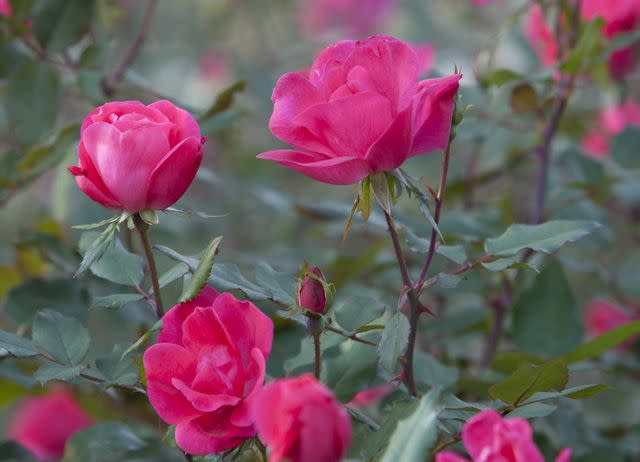
Van Chaplin
Botanical Name: Rosa species and hybrids
Sun Exposure: Full sun
Soil Type: Medium, well-draining, average fertility
Soil pH: Slightly acidic (6.0-6.9)
Roses come in every shade of pink imaginable and are gifted to symbolism gratitude, appreciation, and admiration. When selecting roses for the garden consider how much work you want to put into keeping them healthy and balance this with blossom size. Hybrid tea roses require the greatest attention but reward you with large blooms on long stems. Floribunda roses produce large flower clusters and bloom continuously while requiring less work. These are just two of the many types available.
Bleeding Heart
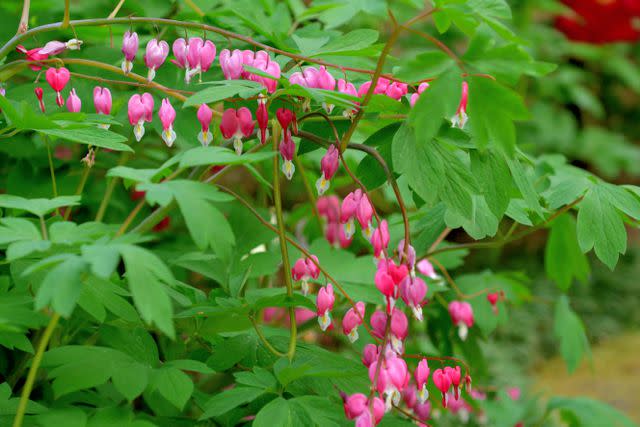
Getty Images
Botanical Name: Lamprocapnos spectabilis
Sun Exposure: Part to full shade
Soil Type: Medium, well-draining, average fertility
Soil pH: Slightly acidic to neutral (6.0-7.5)
This early-season favorite is beloved for its long, gently arching branches from which perfect heart-shaped blooms dangle like jewels. Though breeders have worked to incorporate more red hues into the flowers, the traditional bubblegum pink blooms are most dramatic, as their color truly pops against the fern-like foliage. For a lovely, though less showy native alternative, consider fringed bleeding heart (Dicentra eximia).
Lily
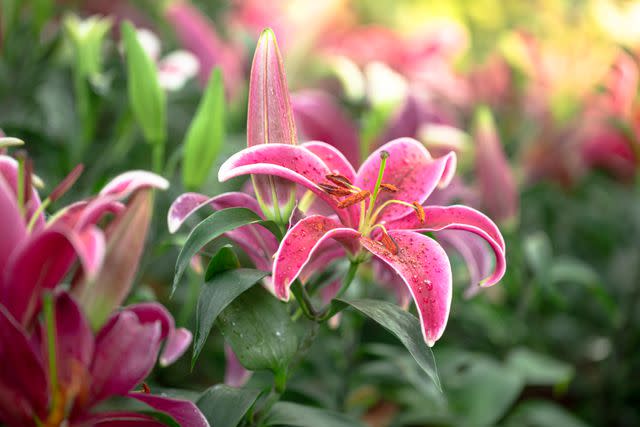
Getty Images/Somnuk Krobkum
Botanical Name: Lilium species and hybrids
Sun Exposure: Full sun to part shade
Soil Type: Medium, well-draining, rich
Soil pH: Slightly acidic to neutral (5.5-7.0)
Bold, vibrant lily blooms bring an abundance of cheer to any garden. These flowers take on many hues, and among the pinks include both warm and cool tones, many with multiply tones or speckles flecking their petals. These summer bloomers benefit from deadheading to direct energy back into their bulbs rather than seed. Cut back flower stems when they begin to yellow. Lilies make lovely cut flowers.
Cleome
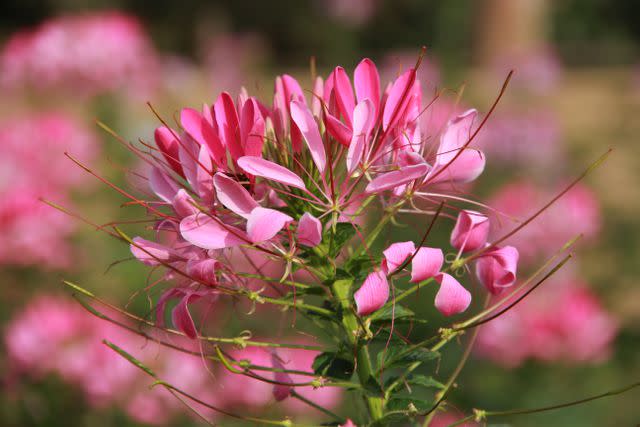
Getty Images
Botanical Name: Cleome houtteana
Sun Exposure: Full sun to part shade
Soil Type: Dry to medium, well-draining, average fertility
Soil pH: Slightly acidic to neutral (5.5-7.0)
Plant a butterfly buffet with this delightful, showy annual. Clusters of large spidery blooms stand atop tall stems and lend the plant its common name of spider flower. Flower clusters are commonly two-toned, with the newest blooms opening a deep rose to magenta pink that fade with age. Plants bloom all summer long and into fall. They reseed themselves in the garden but are not considered invasive.
Foxglove
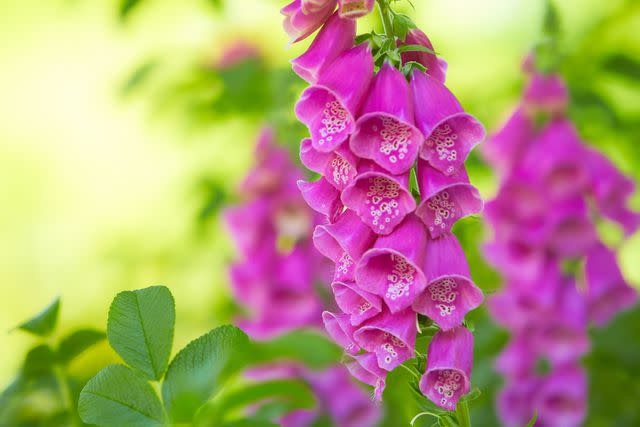
Getty Images/Irina Pislari
Botanical Name: Digitalis purpurea
Sun Exposure: Full sun to part shade
Soil Type: Medium, well-draining, average to rich
Soil pH: Slightly acidic (5.5-6.5)
Add cottage charm to the garden with towering spikes of foxglove. This old-fashioned beauty produces spires of tubular, funnel bell-shaped blooms that attract hummingbirds and other pollinators. Foxgloves are biennial, producing a rosette of basal leaves in their first growing season and flowering in their second year. Plant in back-to-back years for early summer blooms every season as plants reseed in the garden. Note that foxglove is poisonous to people and pets.
Dahlia
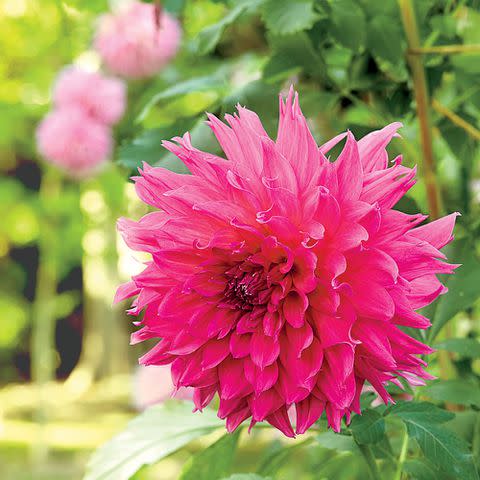
Botanical Name: Dahlia hybrids
Sun Exposure: Full sun to part shade
Soil Type: Moist, well-draining, rich
Soil pH: Slightly acidic to neutral (6.0-7.5)
Blooming mid to late summer, dahlias dazzle with bountiful blooms in a range of colors, shapes, and sizes. From single, anemone-like blossoms to dinner-plate sized flower heads bursting with petals, dahlias are truly remarkable in their diversity. These tender perennials are winter hardy only to USDA Hardiness Zone 7. Elsewhere, the tubers need to be dug after the first frost, dried for a day, and stored in a cool, dry location for the winter.
Egyptian Star Flower
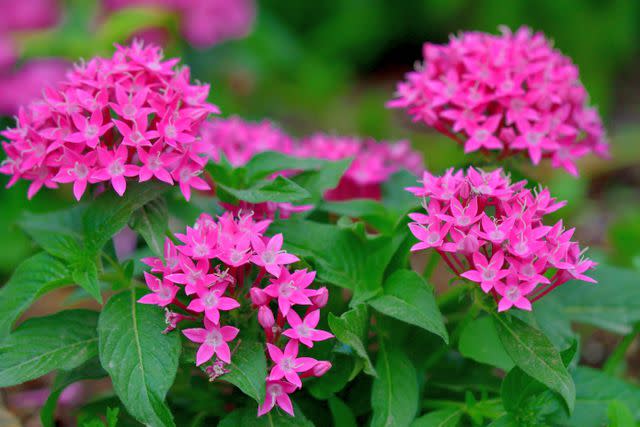
Getty Images
Botanical Name: Pentas lanceolata
Sun Exposure: Full sun
Soil Type: Medium, well-draining, average fertility
Soil pH: Slightly acidic (6.0-6.5)
Named for its rounded clusters of star-shaped blooms, Egyptian star flower is a rugged selection for gardeners throughout the South and beyond. Butterflies and hummingbirds are drawn to the flower heads, which cover plants from summer through fall. This tender perennial is grown as an herbaceous perennial in Zones 10 and 11 and planted as an annual in cooler regions. Plants tolerate heat and humidity, as well as some drought and can be grown easily from seed or cutting. Pinch back young plants to encourage bushier growth.
Azalea
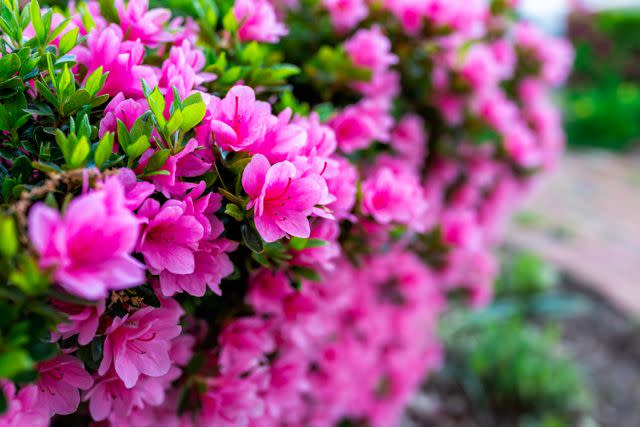
Getty Images
Botanical Name: Rhododendron species and hybrids
Sun Exposure: Partial shade; dappled sun
Soil Type: Medium, well-draining, rich
Soil pH: Acidic (4.5-6.0)
Azaleas thrive throughout the South, making them a perennial favorite. These low-maintenance shrubs are adored for their prolific spring bloom. Plants flower in a range of hues, with blossoms lasting several weeks. Many newer selections rebloom throughout the year, providing pops of color throughout summer and a flush of blooms in fall. You can extend the spring bloom season by combining early- and late-blooming varieties. Strive to stay within the same color family for a pleasing display.
False Spirea
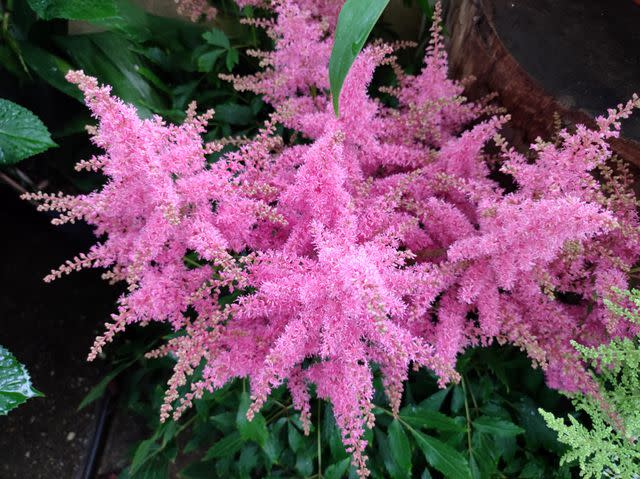
Getty Images/Jana Milin
Botanical Name: Astilbe japonica
Sun Exposure: Partial to Full shade; dappled sun
Soil Type: Moist, well-draining, rich
Soil pH: Slightly acidic to neutral (6.0-7.0)
The feathery plumes of astilbe add welcome color to shade and woodlands gardens. Astilbe can be a problem solver in challenging shade gardens. They tolerate heavy shade, resist deer and rabbit browsing, and can be planted beneath black walnut trees. The flowers attract pollinators, while the blooms and ferny foliage beautify the landscape.
Camellia
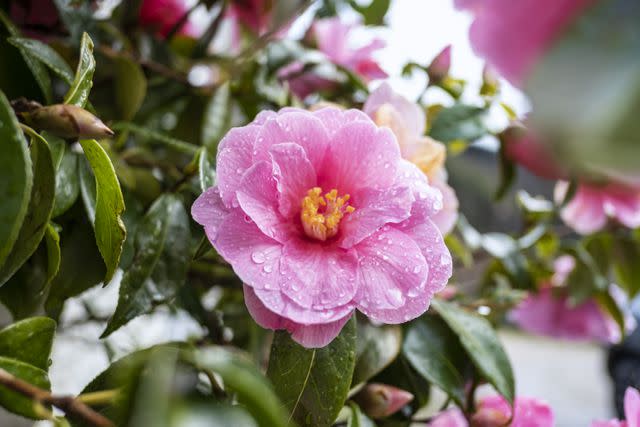
Getty Images/Ana Iacob
Botanical Name: Camellia species and hybrids
Sun Exposure: Partial to full shade
Soil Type: Moist to average, well-draining, rich
Soil pH: Slightly acidic (5.5-6.5)
Producing stunning rose-like blooms, camellias are a staple of the Southern landscape. Two of the most common garden camellias both offer pink varieties but differ in their bloom times. Camellia sasanqua flowers late fall into winter when many other flowering plants have gone dormant. Flowering time of Japanese camellias, Camellia japonica, varies greatly depending on the variety. Some bloom as early as October, others flower as late as mid-March. Take care to provide these evergreen shrubs a protected location .
Garden Phlox
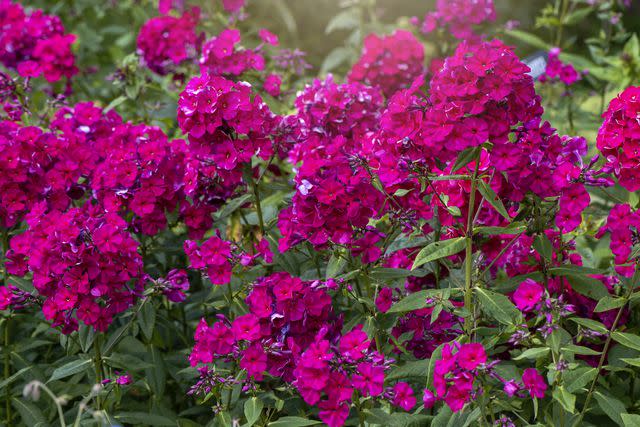
Getty Images/Jacky Parker Photography
Botanical Name: Phlox paniculata
Sun Exposure: Full sun to part shade
Soil Type: Medium, well-draining, average fertility
Soil pH: Slightly acidic to slightly alkaline (6.0-8.0)
This native beauty shines in the summer garden with an abundance of blooms beloved by gardeners and hummingbirds alike. Blossoms come in an array of hues, including many cheerful pinks. The long-lasting blooms stand atop tall stems and make lovely cut flowers. Be sure to provide good air circulation around plants to combat powdery mildew and consider using the newer disease-resistant cultivars.
Petunia
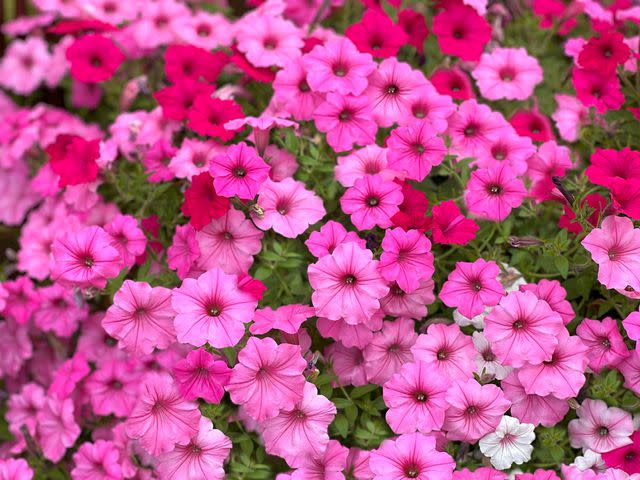
Getty Images/Olena Lialina
Botanical Name: Petunia hybrids
Sun Exposure: Full sun to part shade
Soil Type: Medium, well-draining, average fertility
Soil pH: Slightly acidic (6.0-7.0)
There’s good reason petunias are among the most popular bedding plants—they are relentless bloomers! Flowering spring to frost in vibrant shades with names like ‘Raspberry Blast’ and ‘Bubblegum’, petunias are incredibly easy to grow and endlessly rewarding. Plants flower best in full sun. Pinch back young plants to encourage a bushier habit and deadhead for optimal flower production. Petunias are tender perennials commonly grown as annuals, but are winter hardy in Zones 10 to 11.
Cosmos
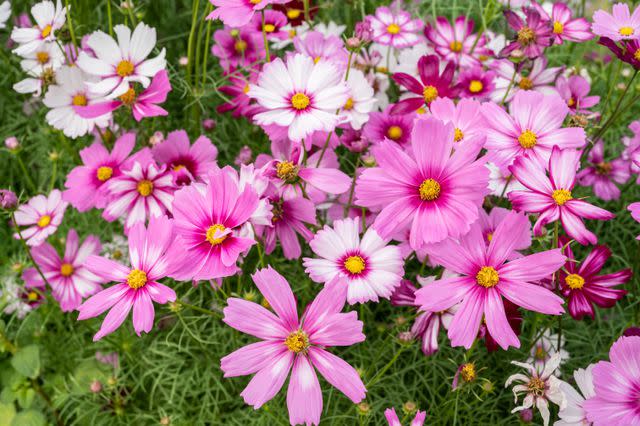
Getty Images
Botanical Name: Cosmos bipinnatus
Sun Exposure: Full sun
Soil Type: Medium to dry, well-draining, average fertility
Soil pH: Neutral to slightly alkaline (7.0-8.0)
This delightful heat-loving annual is a butterfly magnet. The daisy-like blooms twirl skirts of silky petals around a golden eye, soaking up the sun. Cosmos attract a diversity of pollinators including many native bee species, and the seeds are eaten by white-throated sparrows, mourning doves, and American goldfinches. Plants self-seed in the garden for delightful blooms year after year.
Coneflower
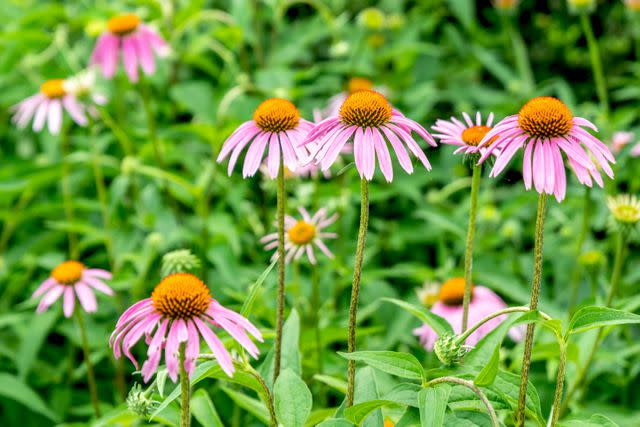
Southern Living/Adrienne Legault
Botanical Name: Echinacea species and hybrids
Sun Exposure: Full sun
Soil Type: Medium to dry, well-draining, average fertility
Soil pH: Slightly acidic to neutral (5.5-7.0)
Despite one of their common names, purple coneflower, echinacea are really more pink than purple. This native wildflower is perfect for massing in beds and borders, where the long-lasting blooms attract butterflies and other pollinators. In autumn, songbirds like the American goldfinch feast on the nutritious seeds. To attract birds and butterflies, select single-flowered cultivars, as the pompom-like double varieties are sterile.
Dianthus
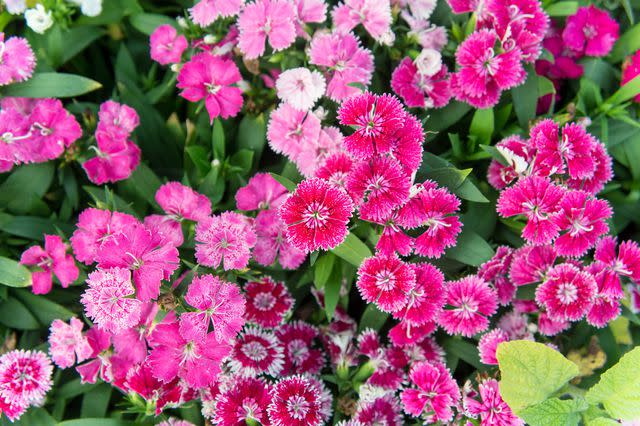
Getty Images
Botanical Name: Dianthus species and hybrids
Sun Exposure: Full sun to part shade
Soil Type: Medium, well-draining, average fertility
Soil pH: Neutral to slightly alkaline (7.0-8.0)
Although the common name “pinks” does not refer to the flower color, this perennial comes in a range of rosy hues. The name instead refers to the fringed or frilled edges of the petals, which look like they’ve been trimmed with pinking shears. The blooms are often rather fragrant, with a spicy clove-like scent. Some species are low-growing and boast evergreen foliage, others stand taller but die back to the ground in winter.
Hardy Hibiscus
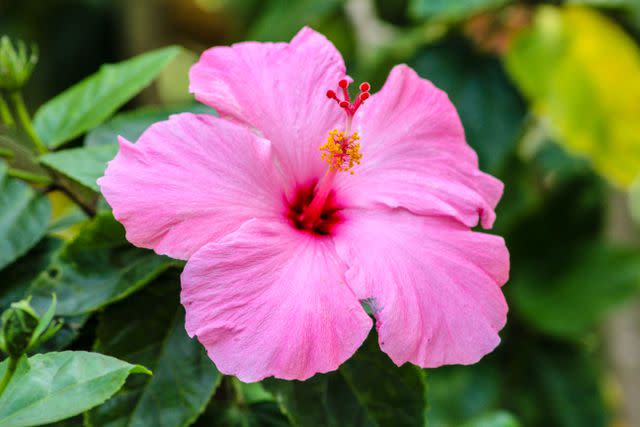
Getty Images/Suzanna Ruby
Botanical Name: Hibiscus hybrids
Sun Exposure: Full sun
Soil Type: Medium to wet, well-draining, rich
Soil pH: Slightly acidic to neutral (5.5-7.5)
This showstopper boasts larger flowers and bolder foliage than its tropical cousins, with some varieties producing dinner-plate sized blooms. Best of all, hardy hibiscus can survive winter temperatures by going dormant, unlike tropical hibiscus which can’t survive below Zone 10. All this while bringing plenty of flair to the garden. Hardy hibiscus plants are bred from an often-complex mixture of species native to the southeastern US, making them well suited to the Southern landscape.
For more Southern Living news, make sure to sign up for our newsletter!
Read the original article on Southern Living.

